|
The multi-generation farm
was established in 1910 and is now operated by Ron, wife Jayne and
son Jay.
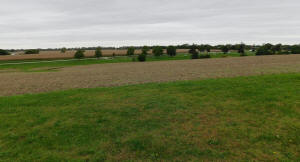
A splendid
southwest view
The hilltop farm has one of the highest elevations in Logan County
and offers splendid views of nearly the whole county looking south
"on a clear day you can see Elkhart Hill," Jayne said. And you can
see a long way westward.
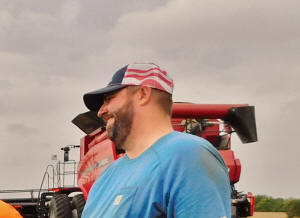
The Kindred family has practiced conservation methods on the land
from the beginning. Jay said grandpa terraced the hillside to the
north, which prevents erosion of soil and runoff of nutrients. One
small section to the west is kept in soybeans as it is too steep to
cultivate corn. The 1,600 acreage is 50/50 corn and soybeans and
they alternate crops each year.

Rotation reduces the amount of nitrogen needed. Soybeans fix
nitrogen into the soil, which is then available for nitrogen hungry
corn to consume the next season. An application of nitrogen is still
needed for corn, but the amount is far less.
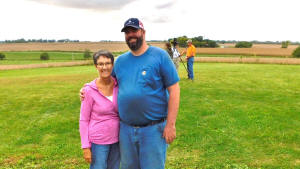
Jayne and Jay
Kindred, as Ron conducts interviews in the background as an Illinois
Soybean Association representative
The farmers have begun using cover crops, which reduce soil loss by
protecting soil from wind and water erosion. The residue layer left
behind also aids in suppression of weed seed development early in
the new crop season. Year after year, the residues are building up,
which increases valuable organic matter, Jayne says.
They've put in cereal rye in the past three winter seasons. Jay said
it is still a learning curve knowing when to kill off the cereal rye
to get the best results.
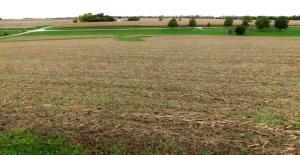
In addition, they've moved to no-till cultivation.
Accumulating layers of crop residues increase organic matter (OM) in
the soil, which further holds moisture, and prevents run off of
soil. The OM holds nutrients where plant roots can access them and
may even draw some naturally occurring nutrients up from lower
regions of soil. Over time, the organic matter creates a mesh
structure that may help reduce soil compaction by equipment used
during planting, mid-season and at harvest.
It takes time, but potential combined benefits of no-till and cover
crop usage include - protection from the elements, soil held in
place, nutrients retained and accessible by plant roots, suppression
of weeds and less soil compaction.

Jay added that about every four years they have soil tests are
performed. So, they still don't know the results of their newest
combined conservation methods of no-till and winter cover crop over
the last three years. Their crops have done well, Jay said, but they
are hoping to see measurable improved soil results when the testing
is done.
Prior land improvements on their hilly acreage have included
installing field drainage tiles in low lying areas.
[to top of second column] |

To-date, no winter cover crops
are known to create a profit by harvesting in this area. However,
many seed choices are available and practical for conservation of
soils. The crops put in during the fall are either terminated after
the winter or self-terminating by winter kill. Cover crop use is
paid in part by some crop insurances and conservation programs.
Cover crop uses are varied:
between seasons, on fallow lands, field edges, ditches and drainage
swales through fields, and in some areas they are even used between
low growing for-profit-crops to reduce the use of herbicides and for
other benefits.
At harvest, the Kindred family puts in long hours, 6 a.m. to 10
p.m., seven days a week. For safety on the roads they prefer to
avoid traveling with their trucks at night. They'll work in the
field into deep dark and leave the last grain filled trucks in the
field till morning.
It is a short night's rest during corn harvest. Jay also has to
travel home to his wife in Normal each night.
While getting crops out of the field at the optimum timing, corn at
the right kernel moisture, and before any event might damage or
destroy the crop, Jayne and Jay admit that sitting out the
occasional rainy day can be a relief when pressing every day for
weeks. Ron was busy at the moment and did not weigh in. He might or
might not like a break, he seems to have a lot of energy and
motivation all the time.
When the later soybean crop is brought in, the hours get a bit
shorter. To start with, the day-light hours are shortening and also
the beans need time to dry off a little from morning dew. If brought
in wet soybeans get rubbery in storage. So, combining soybeans
doesn't begin till 10 or 11 a.m. and dark comes much earlier than
during the corn harvest.
_small.jpg)
For the Kindred family, Ron, Jayne and Jay, it is a way of life.
They take conservation seriously as demonstrated by all the measures
they have employed on their farm. Ron takes time to be involved with
the Illinois Soybean Association and is a spokesperson. And, their
love of farming shows in their land.

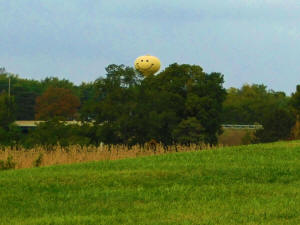
Atlanta's
water tower is always radiating its sunny smiley face on this
farmstead.
|